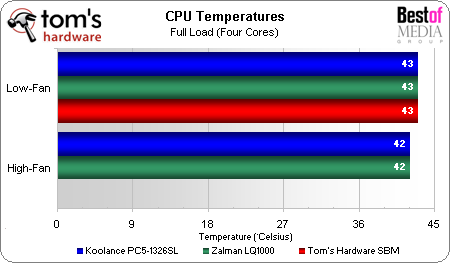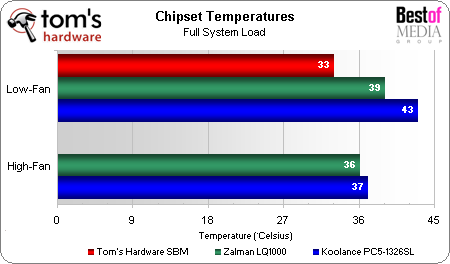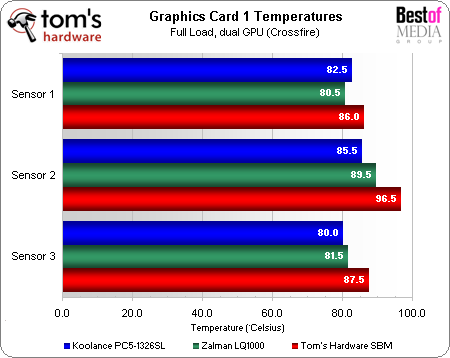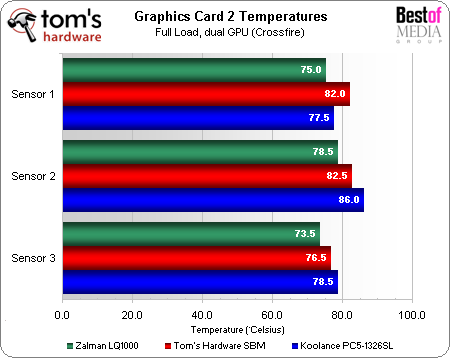Three High-End Liquid-Cooling Cases Compared
Cooling Performance
All tests were conducted at an ambient temperature of 20.6° Celsius, plus or minus 0.1°.
All three systems provided the same CPU temperature at low fan speed. The Koolance and Zalman pre-configured systems dropped CPU temperatures by one degree at maximum speed, while our own assembly was only designed to run at a single speed.
Because our own assembly was not designed to provide airflow over the memory or chipset, we chose the Antec Spotcool fan from the beginning. This gave our design a significant lead in chipset temperatures, but the same fan could also be added to either of the competing products. The real winner here is Zalman, because the huge side fan of its LQ1000 was capable of cooling the chipset to 39° in near-silence, without requiring additional components.
The primary graphics card ran the hottest in our SBM chassis, since both the Zalman LQ1000 and Koolance PC5-1326SL are designed for better airflow. Koolance has the overall best cooling performance, but at significantly higher noise levels.
The Zalman LQ1000 kept the lower card cooler, which seems strange since the Koolance PC5-1326SL blows its radiator fans directly into the graphics card, and here’s the catch : both graphics temperature charts only show low fan-speed results.
At full fan speed, the Koolance PC5-1326SL dropped temperatures of the second graphics card by over 20°, but provided only around 2° additional cooling to the primary card. The Zalman LQ1000 dropped the temperatures of both cards by around 3°. Any card between the graphics card and radiator will block the down draft of the Koolance radiator fans, so it’s best to simply keep in mind that a temperature drop of somewhat more than 20° will benefit only the uppermost card at maximum fan speed.
Get Tom's Hardware's best news and in-depth reviews, straight to your inbox.
-
or buy a cheap case... mod it with a 50 $ dremel... and then add your own watercooling setup and get much better cooling performance...Reply
thats what i'm going to do... not buy some case w/ water cooling.... unless its like a modded lian-li case... but those are like 800 bucks... so no thanks -
nerrawg Whoa the 4870 is still a pretty hot one even with that massive Koolance radiator. I wonder if that can be improved using a custom build with 2 separate loops and radiators - would be a bit more hassle though. Also be interesting to see how it compares to a 4870 X2 - my first assumption would be the X2 is hotter but that might not be the case as there could be a larger flow and surface area to allow for more heat dissipation. If your talking W/C for silent running, then custom built systems with big passive radiators (Toyota anyone?) and a good pump or 2 has to be the only true solution. Otherwise you're just running fans like an air cooling rig and the name of the game is still who has the quietest one..Reply -
yadge nerrawgWhoa the 4870 is still a pretty hot one even with that massive Koolance radiator. I wonder if that can be improved using a custom build with 2 separate loops and radiators - would be a bit more hassle though. Also be interesting to see how it compares to a 4870 X2 - my first assumption would be the X2 is hotter but that might not be the case as there could be a larger flow and surface area to allow for more heat dissipation. If your talking W/C for silent running, then custom built systems with big passive radiators (Toyota anyone?) and a good pump or 2 has to be the only true solution. Otherwise you're just running fans like an air cooling rig and the name of the game is still who has the quietest one..Reply
I'm pretty sure the videocards weren't water cooled. -
nerrawg Hehe whoops you're right - I guess I should have looked at the pics - no wonder it was so hot. Don't understand why they didn't use some splitters and cool 4870beast #1. Can't see how you can complain about noise and temp when you're not even using your full 750-1000W water cooling capasity. Also good eye editor on changing frames per sec to temperature celsius on graph X axis.Reply -
gaiden nice info, though i'm not sure, as hardware gets smaller - lesser heat, would i need a water-cooled setup. personally i think fan setup with a top of the line HS would do plenty. the TJ-09 and Lian Li's are very well built - i have a 7 fan setup + IFX-14 in a lian li 2100 plus II cant hear anything at all. (though it really helps to get good fans :) for GPU's there are several 'spot-cooler' options. overall 7-8 'good' fans + 1 'awesome' cooler would cost only less than 1/2 of the $500 TH spent on water-cooled solution, and the air-cooled should improve air movement inside the case as well.Reply -
stoner133 I find it strange that the video card temps are so high, I run a Koolance system and using their waterblocks on both of my 4870's in crossfire my temps never get above 42c after hours of playing Crysis and my coolent reaches the GPU's after it goes thru the CPU waterblock. The two degree temp difference does happen, AOD does show the first card at 40c while the second is 42c.Reply -
stoner133 thogromor buy a cheap case... mod it with a 50 $ dremelhttp://en.wikipedia.org/wiki/Dremel ... and then add your own watercooling setup and get much better cooling performance... thats what i'm going to do... not buy some case w/ water cooling.... unless its like a modded lian-lihttp://en.wikipedia.org/wiki/Lian_Li case... but those are like 800 bucks... so no thanksThe Koolance cases are modded Lian Li cases and there no where near $800, they start at just under $400 and go to just over $600Reply -
Shadow703793 They could have silver plated the Koolance CPU-340 block instead of gold plating it (silver > than gold in heat transfer).Reply
These kits are worth an entire PC so imo, I would mod it my self. It's not that hard to do, providing you have the time to do it. -
Crashman Reply9463632 said:The Koolance cases are modded Lian Li cases and there no where near $800, they start at just under $400 and go to just over $600
The case with no pump, water block, or reservoir is $400, but what do you do without the parts? A basic liquid cooling kit from Koolance, complete with only the needed parts, starts at around $600.
Also notice:
Test Configuration
Liquid cooling often offers excellent cooling capacity, but that wouldn’t matter much if hot case air destabilized another part of the system. In order to test both, we used an overclockedhttp://en.wikipedia.org/wiki/Overclocking Intel Core 2 Quad processor to heat the liquid and a pair of HD 4870http://en.wikipedia.org/wiki/Radeon_R700 X2 graphics cards to heat the air.
Graphics was left air-cooled to help determine effectiveness of case airflow. It would have been even better to use two 4850's for that, since they don't vent outside the case.




